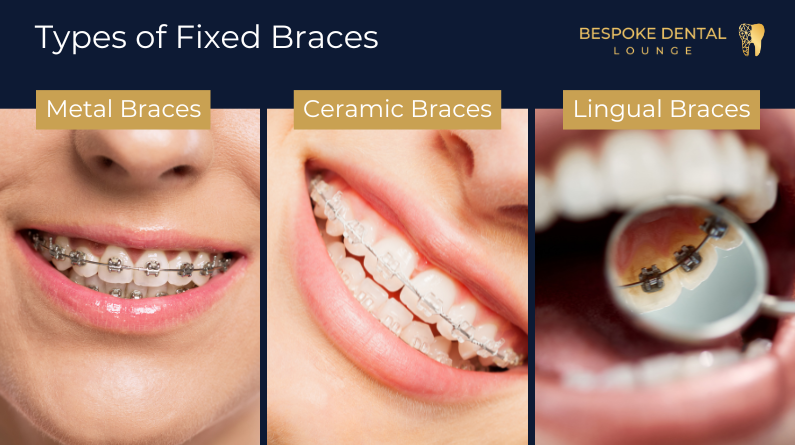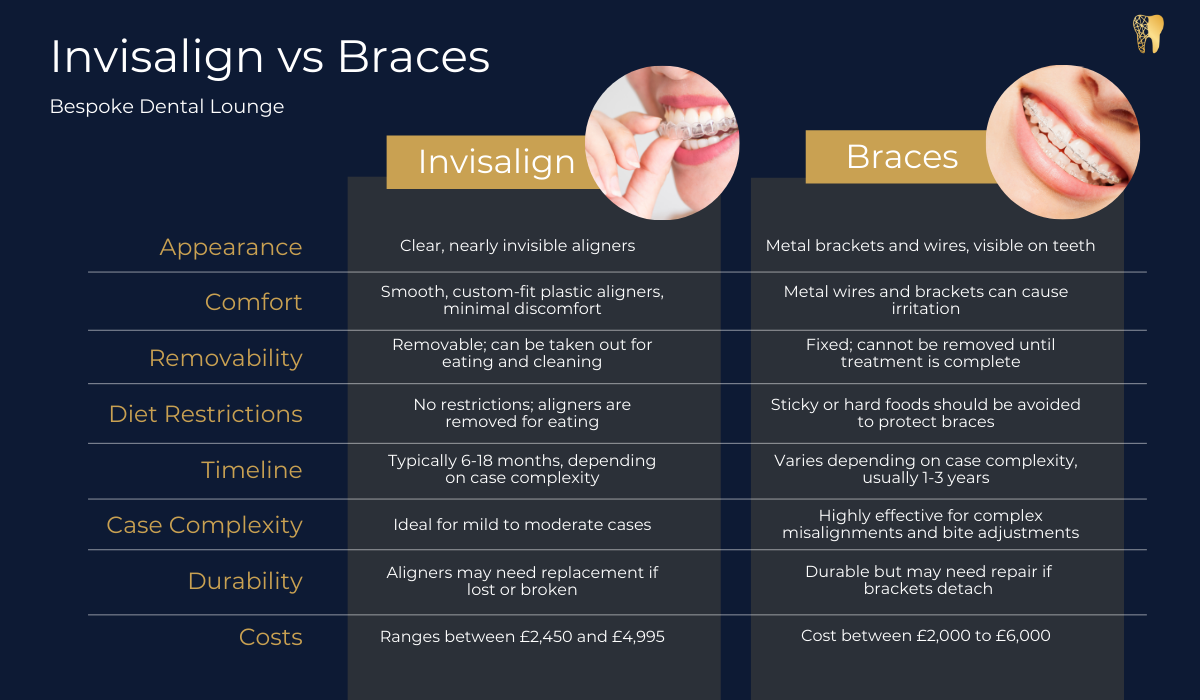Invisalign vs Braces: Which is Right for You?

Looking to straighten your teeth is a big step and investment to make for your future and there can be a lot of factors to consider when choosing which treatment is right for you. We’ve put together a teeth straightening guide to help you understand the pros and cons, along with the differences between Invisalign and Braces.
Invisalign clear aligners and traditional wire braces are both great treatments to straighten teeth and depending on multiple factors, there might be one which is best suited for you.
Invisalign Clear Aligner
Invisalign is an industry-leading teeth-straightening solution that has helped thousands of people around the UK straighten their teeth discreetly. Using a set of clear aligners created using state-of-the-art technology, your teeth are moved gradually over time until your teeth are in your desired position. Invisalign aligners are removable and clear and offer patients the option to maintain their regular lifestyle. Discover more about Invisalign in Dorking.
Treats Range of Case
Invisalign can treat a range of cases, from mild to moderate and complex. These include overcrowding (teeth overlapping and not straight), and spacing (gaps between teeth). Invisalign also treats several bite issues from under and overbites to cross bites and open bites. Invisalign can treat complex cases over a longer period, but depending on the complexity of the case, traditional braces may be required.
Treatment Takes 6-18 Months
Your timeline for Invisalign depends on your personalised treatment and the complexity of your case. Typically, Invisalign treatments take 6-18 months to complete, with your clear aligners being switched every 1-2 weeks for consistent progress. More complex cases can take 18-14 months or longer.
Several factors may delay completing your Invisalign, including ensuring you wear your aligners for the recommended 22 hours per day.
Invisalign Visual Benefits
Clear aligners provide an almost invisible treatment option.
Invisalign aligners are made from a clear material and are nearly invisible when worn, which is a huge factor that attracts a lot of patients. Wearing Invisalign clear braces doesn’t change your appearance and with the aligners being removable, you have the option to remove your Invisalign clear braces when needed. Offering the flexibility for Invisalign to fit into your lifestyle.
No Diet Restrictions
With no dietary restrictions, you can eat as you normally would. Just remove your aligners and brush before re-inserting them. We remind patients to take good care of their aligners when removing them and to place them into their provided Invisalign case to reduce the risk of breaking them, which can delay your treatment. Aligners also make oral hygiene simple—just clean them daily and continue your daily oral routine of brushing and flossing twice a day!
Suitable for Teenagers and Adults
Invisalign is a popular choice among adults due to its flexibility and discreet appearance. Unlike traditional braces, Invisalign aligners are removable, allowing patients to maintain their lifestyle with minimal adjustments—making it an especially appealing option for adults.
Invisalign is also a great choice for teenagers who prefer a more subtle, “clear” alternative to braces. However, it’s crucial to emphasise the importance of discipline for achieving the desired results. Teens must wear their aligners for the recommended 22 hours per day to ensure treatment success.
Invisalign Cost
The cost of Invisalign typically ranges between £2,450 and £4,995, depending on several factors. These include the complexity of your case, the number of aligners needed, and any additional options. Additional costs may apply for treatments like fixed braces, which provide extra support to help your teeth maintain their new position.
Traditional Braces
Traditional braces, often referred to as “fixed braces,” are a time-tested and reliable orthodontic solutions suitable for addressing a wide range of dental issues. Whether you’re dealing with mild misalignments or more complex concerns like severe bite problems, fixed braces provide precise, consistent results. Designed to stay in place throughout treatment, these braces offer unparalleled control over tooth movement, making them a trusted choice for achieving a beautifully aligned smile.
Treats Most Cases
Fixed braces are a versatile orthodontic treatment option capable of addressing almost any dental alignment or bite issue. From minor crowding to more severe cases like overbites, underbites, and crossbites, fixed braces offer a comprehensive solution for patients of all ages. Their precise design allows orthodontists to tackle even the most complex cases, ensuring effective and long-lasting results.
Treatment Takes 18-36 Months
The duration of fixed braces treatment typically ranges from 18 to 36 months, depending on the complexity of your case and your unique orthodontic needs. While this timeframe may seem significant, it ensures gradual, controlled tooth movement for optimal results. Your orthodontist will closely monitor your progress and make adjustments as needed to keep you on track toward your new straight smile.
Visual and Lifestyle Factors
While traditional metal fixed braces are visible, advancements in orthodontic technology have made them more discreet and comfortable than ever before. Options like ceramic braces use clear or tooth-coloured brackets to blend in with your teeth, minimising their appearance. For some cases, the option of lingual braces can be an option, which involves securing your braces to the back of your teeth instead of the front. Although fixed braces require some lifestyle adjustments, they are a dependable solution for achieving a beautifully aligned smile.
Types of Fixed Braces

Fixed braces come in various options to suit different needs and preferences. Traditional metal braces are popular and effective, offering durability and efficiency. For a more subtle appearance, ceramic braces use clear or tooth-coloured brackets to blend in with your smile. Lingual braces, another option, are fitted to the inside of your teeth, making them virtually invisible. Each type is tailored to provide the best results for your specific case.
Diet and Maintenance
When wearing fixed braces, it’s important to be mindful of your diet and oral hygiene routine. Avoid sticky, hard, or chewy foods that can damage the brackets or wires. This can include hard sweets, popcorn, toffee and more. Maintaining excellent oral hygiene is crucial—regular brushing and flossing help prevent plaque buildup around the braces. Your orthodontist will provide tips and tools to make caring for your braces as simple as possible.
Cost of Braces
Traditional braces can vary in cost depending on the complexity of your case and the type of braces you choose (metal, ceramic, or lingual). Typically, prices range from £2,000 to £6,000 for a full course of treatment. While traditional braces may seem like a significant investment, they are often more affordable than alternatives like Invisalign. Additionally, many dental practices offer payment plans to spread the cost. Discussing your options with your dentist to get an accurate quote tailored to your needs is best.
Invisalign vs Braces: Key Comparisons
Conclusion
Both Invisalign and traditional braces have their unique advantages. If aesthetics, convenience, and flexibility are priorities, Invisalign may be your choice. For complex cases or budget-friendly options, traditional braces are ideal.
Still, wondering how Invisalign works or how much Invisalign costs? Explore our Invisalign Dorking page or view our Dental Fees for detailed pricing. You can also visit the official Invisalign site for further insights.
